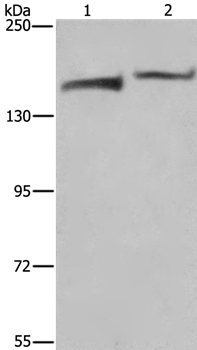

| WB | 咨询技术 | Human,Mouse,Rat |
| IF | 咨询技术 | Human,Mouse,Rat |
| IHC | 1/50-1/200 | Human,Mouse,Rat |
| ICC | 技术咨询 | Human,Mouse,Rat |
| FCM | 咨询技术 | Human,Mouse,Rat |
| Elisa | 咨询技术 | Human,Mouse,Rat |
| Aliases | CT31; PLU1; PUT1; PLU-1; JARID1B; RBBP2H1A |
| Entrez GeneID | 10765; |
| WB Predicted band size | 176kDa |
| Host/Isotype | Rabbit IgG |
| Antibody Type | Primary antibody |
| Storage | Store at 4°C short term. Aliquot and store at -20°C long term. Avoid freeze/thaw cycles. |
| Species Reactivity | Human,Mouse |
| Immunogen | Synthetic peptide corresponding to a region derived from internal residues of human lysine (K)-specific demethylase 5B |
| Formulation | Purified antibody in PBS with 0.05% sodium azide. |
+ +
以下是关于KDM5B抗体的3篇参考文献及其摘要概括:
---
1. **文献名称**:*KDM5B (JARID1B) promotes tumorigenesis through transcriptional regulation of Wnt/β-catenin signaling in melanoma*
**作者**:Christensen, J., et al.
**摘要**:该研究利用KDM5B抗体进行染色质免疫沉淀(ChIP)和免疫组织化学分析,揭示KDM5B通过调控Wnt/β-catenin信号通路促进黑色素瘤进展,抗体特异性验证为机制研究提供了关键支持。
2. **文献名称**:*A monoclonal antibody-based approach to study the role of KDM5B in cell cycle progression*
**作者**:Lin, W., et al.
**摘要**:研究团队开发了一种高特异性KDM5B单克隆抗体,并通过Western blot和免疫荧光实验证明其在细胞周期调控中的作用,抗体成功用于检测KDM5B在不同细胞周期阶段的亚细胞定位。
3. **文献名称**:*KDM5B demethylates H3K4me3 to regulate gene expression and stem cell self-renewal*
**作者**:Roesch, A., et al.
**摘要**:通过KDM5B抗体进行功能丧失实验,研究发现KDM5B通过去除H3K4me3修饰抑制干细胞分化相关基因,抗体在肿瘤干细胞模型中的应用揭示了其在维持干细胞特性中的关键作用。
---
这些文献展示了KDM5B抗体在机制研究、抗体开发及疾病模型中的多样化应用。如需具体DOI或年份,可进一步补充。
The KDM5B antibody is a crucial tool in studying the KDM5B (Lysine-Specific Demethylase 5B) protein, also known as JARID1B or PLU-1. KDM5B belongs to the JARID1 subfamily of histone demethylases that specifically catalyze the removal of methyl groups from tri- and dimethylated lysine 4 on histone H3 (H3K4me3/me2), regulating gene expression by modifying chromatin structure. It plays a pivotal role in epigenetic regulation, influencing cellular processes such as differentiation, proliferation, and DNA repair. Dysregulation of KDM5B is linked to cancer progression, drug resistance, and stem cell maintenance, making it a target in oncology and developmental biology research.
KDM5B antibodies are widely used in techniques like Western blotting, immunofluorescence, chromatin immunoprecipitation (ChIP), and immunohistochemistry to detect protein expression, localization, and histone modification interactions. These antibodies help elucidate KDM5B's role in silencing tumor suppressor genes, promoting cell cycle progression, and maintaining cancer stem cell populations. Validated for specificity and sensitivity, high-quality KDM5B antibodies are essential for studying its involvement in epigenetic mechanisms, therapeutic resistance, and potential as a biomarker or drug target. Research utilizing these antibodies contributes to advancing understanding of epigenetic dysregulation in diseases and developing targeted therapies.
×